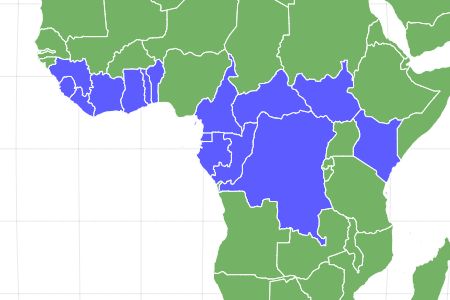Long and heavy spiralled horns!
Advertisement
Bongo Scientific Classification
- Kingdom
- Animalia
- Phylum
- Chordata
- Class
- Mammalia
- Order
- Artiodactyla
- Family
- Bovidae
- Genus
- Tragelaphus
- Scientific Name
- Tragelaphus eurycerus
Read our Complete Guide to Classification of Animals.
Bongo Conservation Status
Bongo Facts
- Prey
- Leaves, Bark, Grasses
- Name Of Young
- Calf
- Group Behavior
- Solitary/Herd
- Fun Fact
- Long and heavy spiralled horns!
- Estimated Population Size
- 28,000
- Biggest Threat
- Habitat loss
- Most Distinctive Feature
- 10 - 15 white stripes on body
- Other Name(s)
- Lowland Bongo, Mountain Bongo
- Gestation Period
- 9 months
- Habitat
- Dense forests and bamboo thickets
- Predators
- Leopards, Hyenas, Lions
- Diet
- Herbivore
- Average Litter Size
- 1
- Lifestyle
- Diurnal
- Common Name
- Bongo
- Number Of Species
- 2
- Location
- Western, Eastern and Central Africa
- Slogan
- Long and heavy spiralled horns!
- Group
- Mammal
Bongo Physical Characteristics
- Color
- Brown
- Red
- Black
- White
- Orange
- Chestnut
- Skin Type
- Fur
- Top Speed
- 43 mph
- Lifespan
- 10 - 18 years
- Weight
- 500 - 900 lbs
- Length
- 1.7m - 2.5m (5.5ft - 8.25ft)
- Age of Sexual Maturity
- 20 - 24 months
- Age of Weaning
- 6 months
Classification And Evolution
The Bongo is a large species of antelope that is found inhabiting the jungles and forests of Eastern, Western, and Central Africa. They are the largest forest-dwelling antelope species and one of the most distinctive, with a chestnut-colored coat and long horns that spiral as high as 90cm in males.
The coloration of bongos is an evolution over the years to help them actually blend into their dense surroundings and provide them protection from prey as they forage for food. The mountain bongo diverged away from the lowland bongo to adapt to the mountainous terrain.
2 Types of Bongo
There are only two subspecies of the bongo. They are:
- Mountain Bongo (Eastern Bongo) – The mountain bongo is much rarer than its lowland relatives. They can only be found in the mountains in Kenya. They are larger and heavier, too.
- Lowland Bongo (Western Bongo) – The lowland bongo is more prevalent and primarily found in the forests of Central Africa. Out of all the African forest antelope, these are the largest and have the most striking colorful.
Both species of Bongo are threatened by both hunting and habitat loss with populations having declined significantly enough for it to be listed as a near-threatened species by the IUCN, as although it still has a relatively wide distribution, populations are becoming more and more isolated.
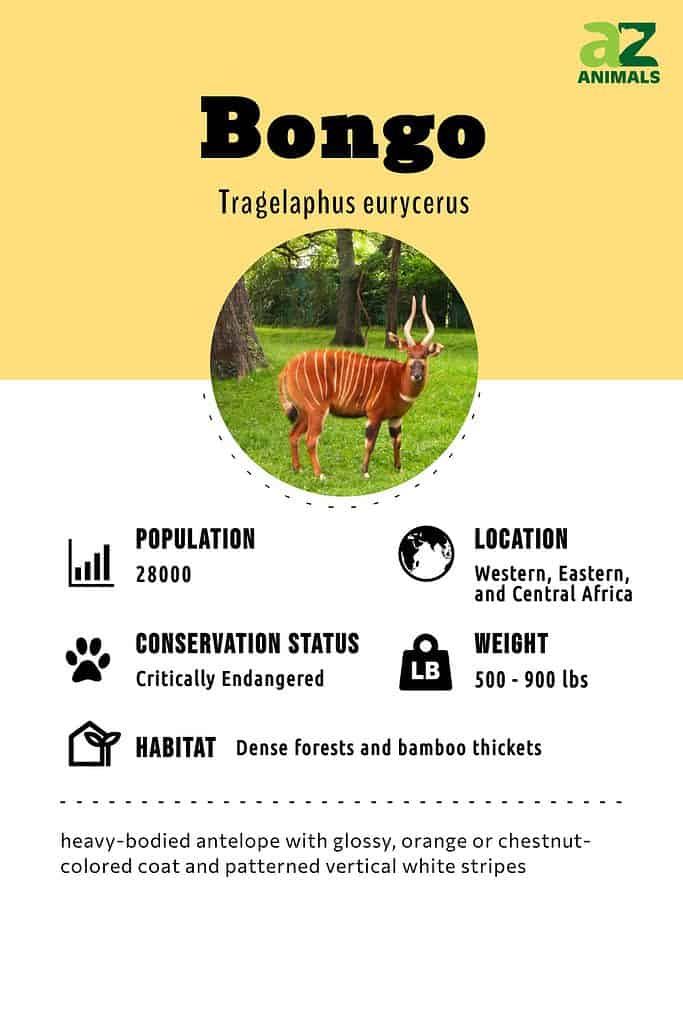
Anatomy and Appearance
The Bongo is a large and heavy-bodied antelope with a short and glossy, orange or chestnut-colored coat that is darker on the underside and patterned with between 10 and 15 vertical white stripes that help the Bongo to remain camouflaged in the dense jungle. They also have distinctive white markings on their cheeks, a white chevron between the eyes and nose, and a white crescent-like shape on their chest. The legs of the Bongo are banded with both white and black and their long tail has a tufted tip. Bongos also have large ears giving them very sensitive hearing and a long prehensile tongue which allows them to grip onto leaves higher up and strip them from the branches with ease. Their distinctive spiraled horns usually have either one or one-and-half twists, with those of males being longer and more coiled than the horns of the slightly smaller and lighter-colored females. Bongos also have a thin mane that runs along their body from the shoulders to the rump.
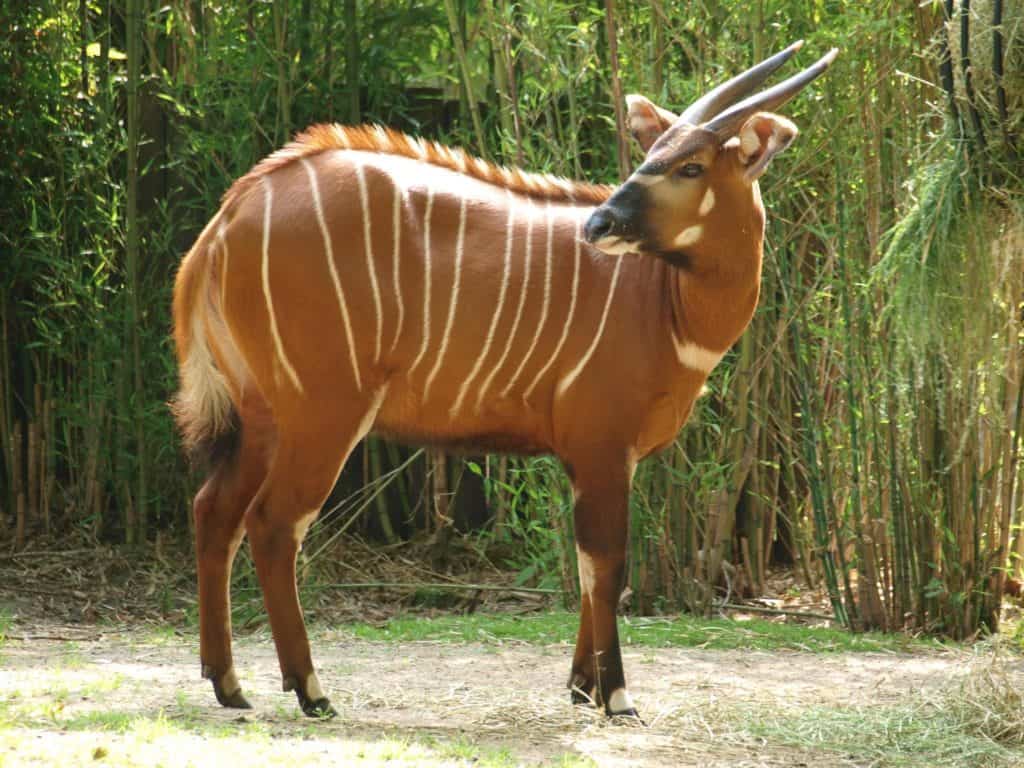
Bongos are orange and chestnut colored, and they have patterned vertical white stripes that help the Bongo to remain camouflaged in the dense jungle.
Distribution and Habitat
The Bongo is an animal that is natively found inhabiting the dense forests of Eastern, Western, and Central Africa and although it is still found in a number of different countries today, populations are decreasing in size with the Bongo now actually considered to be extinct from some regions. The Lowland Bongo inhabits the dense lowland forests and bamboo thickets of Western and Central Africa, and although is still found throughout much of its historical range in Central Africa, is becoming rarer in the West. Mountain Bongos were once found in the highland forests of both Kenya and Uganda but are now restricted to just four areas in Kenya after having disappeared from Uganda at the beginning of the twentieth century. Populations have decreased rapidly throughout much of their natural range due to habitat loss, mainly in the form of deforestation.
Behavior and Lifestyle
The Bongo is a shy and elusive animal that people seldom see due to its highly nocturnal lifestyle. As with many other antelope species, Bongos turn and flee almost immediately when they feel threatened and can disappear quickly into the surrounding forest, running with their horns laid back against their body to prevent them from getting tangled up in the vegetation. Male Bongos are solitary animals and will only come into contact with other Bongos to breed, whereas although females can be found on their own, they often form herds that can contain up to 50 members and consist of the females and their young (for protection). Bongos produce a variety of different calls so they are able to communicate including grunts, snorts, moos, and bleating to warn others of approaching danger or when they are in distress.
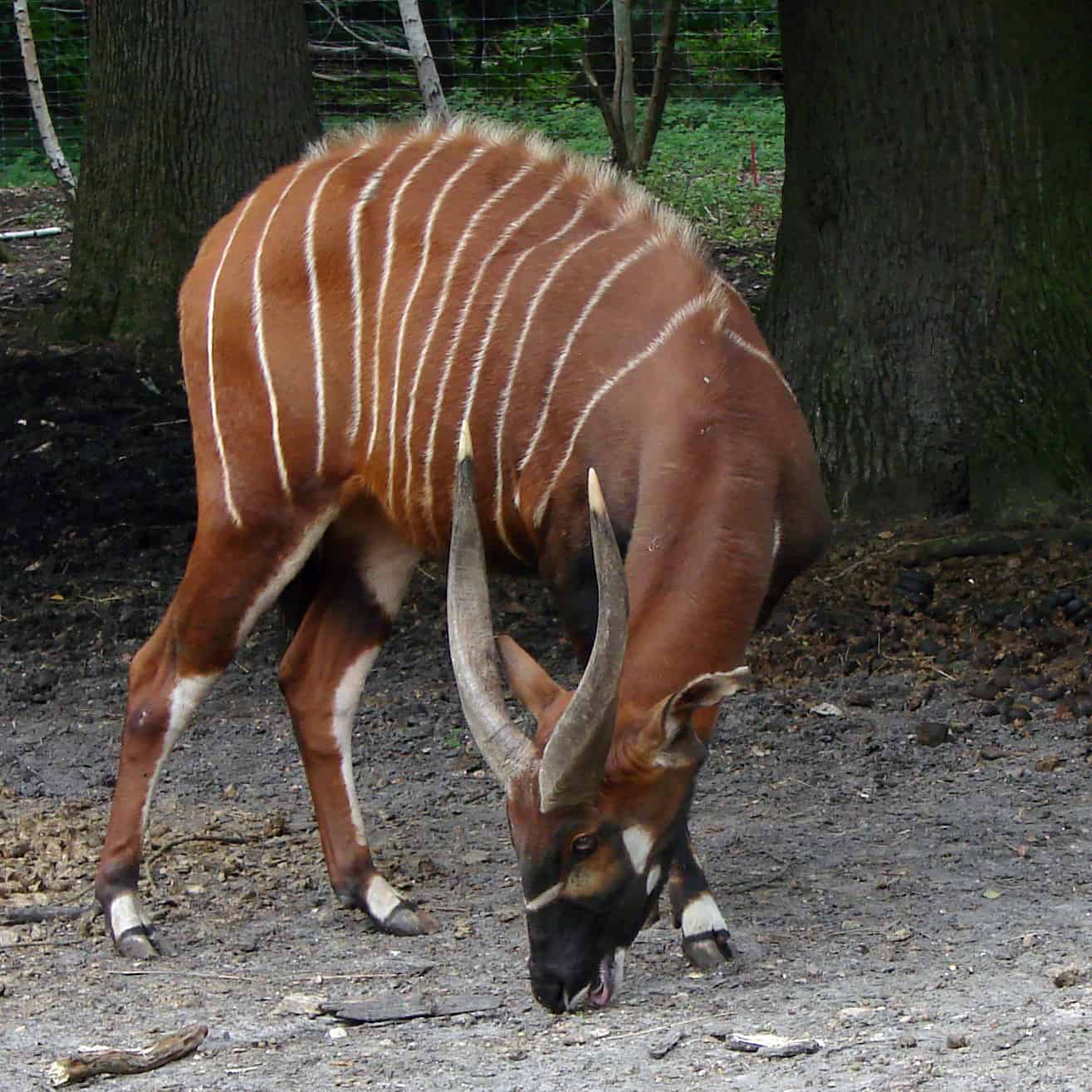
Bongos turn and flee almost immediately when they feel threatened and can disappear quickly into the surrounding forest.
©Vassil, Public domain, via Wikimedia Commons – Original / License
Reproduction and Life Cycles
Most mating tends to occur between October and January, after which the female Bongo will give birth to a single calf following a gestation period that lasts for around 9 months. In order to try and protect the vulnerable calf from predators, females give birth to their calf in dense vegetation where she leaves it lying silently for about a week. During this time, the mother returns regularly to nurse her calf and when the calf is strong enough they both join up with other females and their young for better protection. Bongo calves grow relatively fast and their horns begin to show by the time they are three or four months old. Weaning occurs at six months but calves tend to remain with the nursery group for longer.
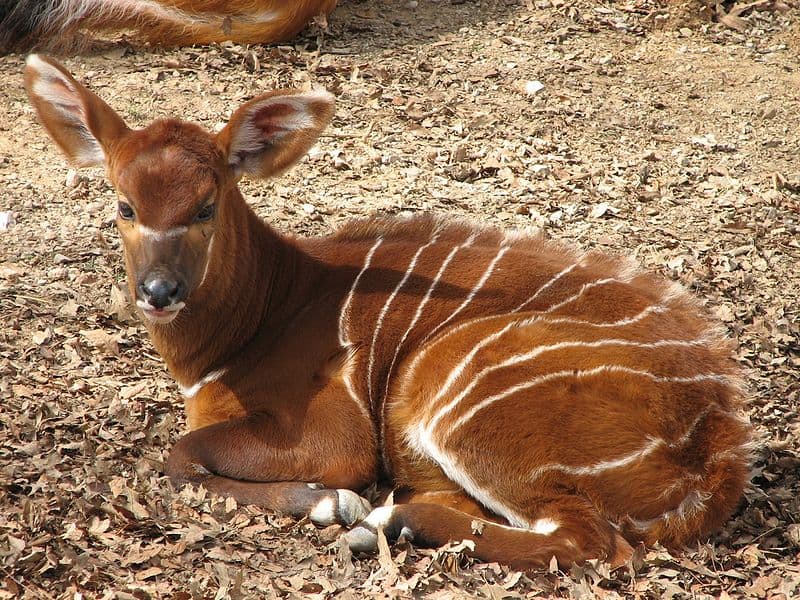
Bongo calves grow relatively fast and their horns begin to show by the time they are three or four months old.
©Trisha Shears Ltshears from Louisville, Kentucky, United States, CC BY-SA 2.0, via Wikimedia Commons – Original / License
Diet and Prey
The Bongo is a herbivorous mammal which means that they only feed on plant matter in order to gain the nutrition that they need to survive. Bongos are selective browsers that feed on leaves, roots, bark, and grasses under the cover of night to keep them safer from the numerous carnivorous predators that they share their habitats with. The Bongo has a prehensile tongue which helps it to reach fresh leaves higher up and also aids it when pulling roots out of the ground. Like other antelopes (and cattle which they are closely related to), the Bongo has a four-chambered ruminating stomach to help it to break down the cellulose that the plants contain. Food passes through their digestive system very slowly in comparison to other mammals to maximize their nutritional intake.
Predators and Threats
Bongos are prey to numerous large predators in their surrounding environments with Leopards being their most common natural threat along with Lions in certain areas. The young calves are also vulnerable to predation from Pythons and Hyenas throughout much of their natural range. Another big threat to Bongos is the fact that they are particularly susceptible to disease with the entire population has been nearly wiped out in the late 1800s. They are, however, at the biggest risk from people who don’t just hunt them both directly and by setting snares but have also obliterated much of their vast natural range through deforestation to both make way for agriculture and to gather tropical woods for the timber industry.
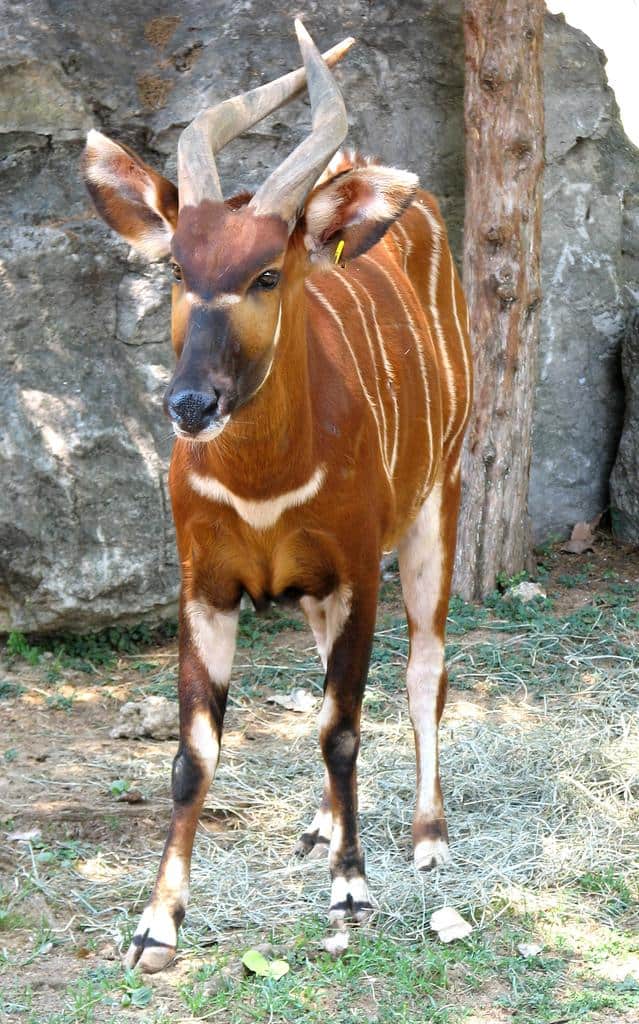
Bongos are susceptible to disease and were almost wiped out in the 1800s.
©Trisha Shears from Louisville, Kentucky, United States, CC BY-SA 2.0, via Wikimedia Commons – Original / License
Bongo Interesting Facts and Features
Although they tend to be most active between dusk and dawn, Bongos are known to browse during the day occasionally but will never leave the dense vegetation that surrounds them. To help them to cool down in the heat, Bongos wallow in mud which they then rub onto a tree as a way of polishing their smooth and heavy horns. Despite being hunted for food in many areas, in others, there is a great deal of superstition surrounding the Bongo by the native people. Some believe that not only eating but just touching Bongo will cause the individual to have spasms and they are therefore not too affected by hunting in these places.
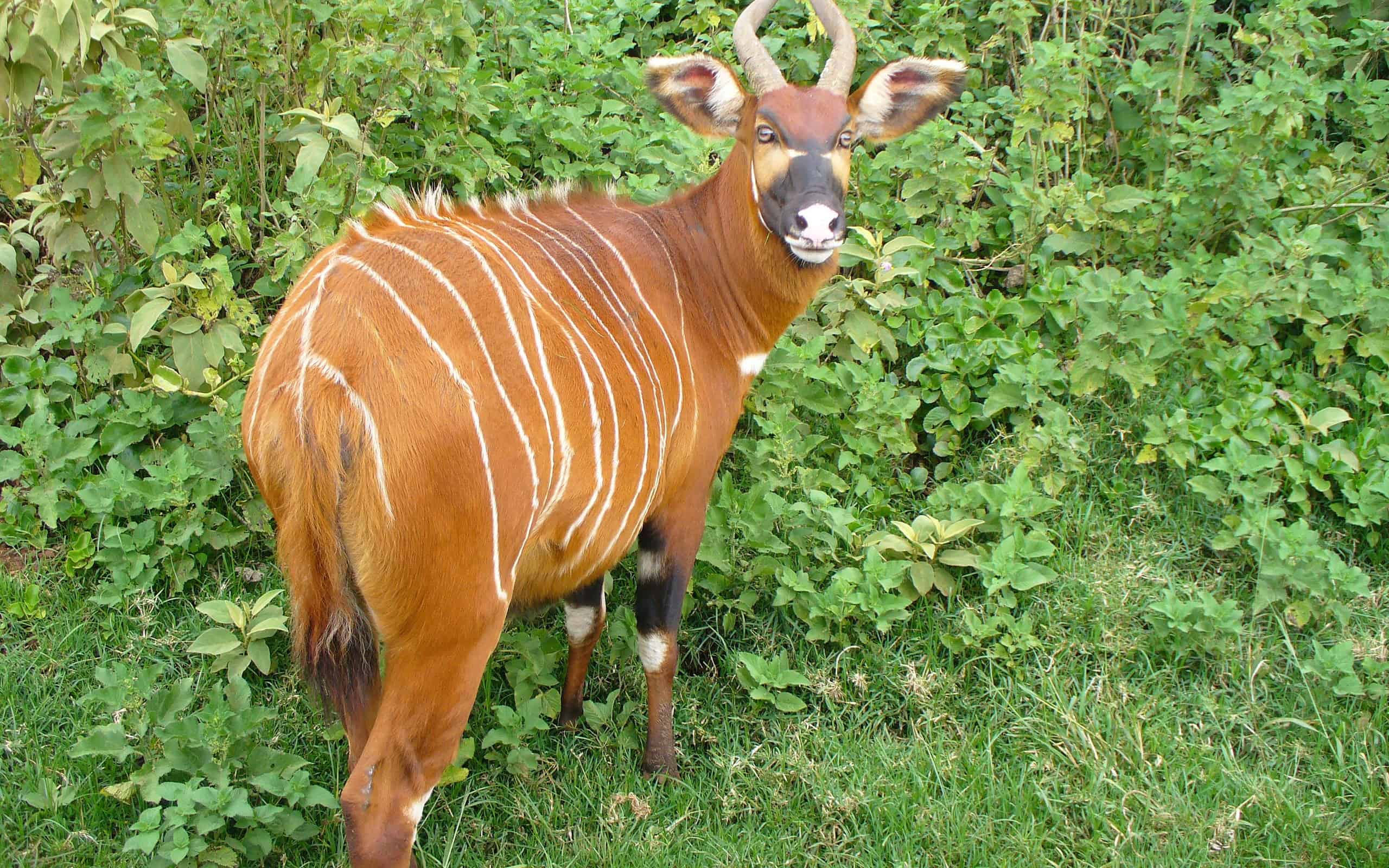
Bongos are known to browse during the day occasionally but will never leave the dense vegetation that surrounds them.
©Chuckupd at English Wikipedia, Public domain, via Wikimedia Commons – Original / License
Relationship with Humans
In many areas throughout their natural range, Bongos have been hunted by people for meat but also became a prize target for big-game trophy hunters which devastated local populations. The biggest impact that people have had on the Bongo though is the fact that vast areas of their natural habitats have disappeared to make room for agriculture and to provide grazing for livestock. This increasing closeness to Humans has led to outbreaks of disease in Bongos, along with severe population declines due to their dwindling habitats and therefore, an increasing lack of both food and suitable forest cover which Bongos heavily rely on.
Conservation Status and Life Today
Today, the Bongo is listed by the IUCN as an animal that is Near Threatened to extinction from the wild in the near future. Although the Mountain Bongo has always been rare it is feared that there could be as few as only 75 individuals left in the highland forests of Kenya, where they are now protected. The Lowland Bongo is becoming rarer in Western Africa but populations although decreasing, remain widespread throughout much of their historical range in Central Africa.
View all 284 animals that start with BBongo FAQs (Frequently Asked Questions)
Are Bongos herbivores, carnivores, or omnivores?
Bongos are Herbivores, meaning they eat plants.
What Kingdom do Bongos belong to?
Bongos belong to the Kingdom Animalia.
What class do Bongos belong to?
Bongos belong to the class Mammalia.
What phylum to Bongos belong to?
Bongos belong to the phylum Chordata.
What family do Bongos belong to?
Bongos belong to the family Bovidae.
What order do Bongos belong to?
Bongos belong to the order Artiodactyla.
What type of covering do Bongos have?
Bongos are covered in Fur.
What genus do Bongos belong to?
Bongos belong to the genus Tragelaphus.
Where do Bongos live?
Bongos live in western, eastern, and central Africa.
In what type of habitat do Bongos live?
Bongos live in dense forests and bamboo thickets.
What are some predators of Bongos?
Predators of Bongos include leopards, hyenas, and lions.
How many babies do Bongos have?
The average number of babies a Bongo has is 1.
What is an interesting fact about Bongos?
Bongos have long and heavy spiraled horns!
What is the scientific name for the Bongo?
The scientific name for the Bongo is Tragelaphus eurycerus.
What is the lifespan of a Bongo?
Bongos can live for 10 to 18 years.
What is a baby Bongo called?
A baby Bongo is called a calf.
How many species of Bongo are there?
There are 2 species of Bongo.
What is the biggest threat to the Bongo?
The biggest threat to the Bongo is habitat loss.
What is another name for the Bongo?
The Bongo is also called the lowland bongo or mountain bongo.
How many Bongos are left in the world?
There are 28,000 Bongos left in the world.
How fast is a Bongo?
A Bongo can travel at speeds of up to 43 miles per hour.
How to say Bongo in ...
Thank you for reading! Have some feedback for us? Contact the AZ Animals editorial team.
Sources
- David Burnie, Dorling Kindersley (2011) Animal, The Definitive Visual Guide To The World's Wildlife / Accessed November 6, 2008
- Tom Jackson, Lorenz Books (2007) The World Encyclopedia Of Animals / Accessed November 6, 2008
- David Burnie, Kingfisher (2011) The Kingfisher Animal Encyclopedia / Accessed November 6, 2008
- Richard Mackay, University of California Press (2009) The Atlas Of Endangered Species / Accessed November 6, 2008
- David Burnie, Dorling Kindersley (2008) Illustrated Encyclopedia Of Animals / Accessed November 6, 2008
- Dorling Kindersley (2006) Dorling Kindersley Encyclopedia Of Animals / Accessed November 6, 2008
- David W. Macdonald, Oxford University Press (2010) The Encyclopedia Of Mammals / Accessed November 6, 2008
- Bongo Information / Accessed November 6, 2008
- About Bongos / Accessed November 6, 2008
- Bongo Conservation / Accessed November 6, 2008

